There’s no one set format in which all comics are written. Things vary – sometimes wildly – from writer to writer, and from book to book. For instance, an author who spends a lot of time writing Superman comics will probably struggle for a little while if they suddenly switch to Batman comics, and probably even more so if they move to a different company and have to learn how things are done there. There’s even more of a striking difference between comics written today and those from the sixties; everything from artistic styles to speech patterns to narration boxes have changed in some way.
Even though there’s no real standard to comics, it’s easy to tell that Deadpool is not the norm. There are several aspects that make the book stand out, from the character himself to the tone of the book right down to the underlying structure. When you take all of it together, you end up with a very unique book that’s completely enjoyable to read.
A quick note before we continue: if your only exposure to Deadpool is the Ryan Reynolds version in X-Men Origins: Wolverine, think of him as more like he was in the first half of the movie, not the second. Or, better yet, pretend that didn’t happen and start anew.
Deadpool stars Wade Wilson, also known as “The Merc with a Mouth.” It’s hard to give a history of the character, because the only thing we know about him for sure is that he has a healing factor to rival Wolverine’s. Most of the stories we get about Deadpool are told from his point of view, and he’s a very unreliable narrator. He can’t be trusted to tell the truth at any time, not even in his own head – he’s got problems with memory and thought processes, which may or may not be self-inflicted. He’s been described by many – himself included – as straight up crazy, and though he’s certainly got some traits that would land him on the crazy side of the spectrum, it’s hard to pin down how much of it is legitimate and how much is put on for effect.
It’s a brilliant way to write a character, because it allows for a lot of the authorial variation I mentioned before, and also leaves space for the character to take unexpected turns. If Deadpool does something that seems to come out of left field and is then explained later, it will still fit in with who he is… because we’re never really sure of who he is, or where he’s come from, or what his motivations are. We’re constantly kept on our toes, always with an idea of who the man behind the mask is, but never sure how right we might be – or if we’re even in the same ballpark as the truth.
Narration boxes are a relatively standard part of comics – usually a way for the character to express his or her thoughts, or a way for an omniscient narrator to relate important information to the readers. In Deadpool, there are two narration boxes, and they’re not showing us Wade’s thoughts or important narration. Instead, they represent two different voices in Wade’s head. They hold conversations with each other and with Wade.
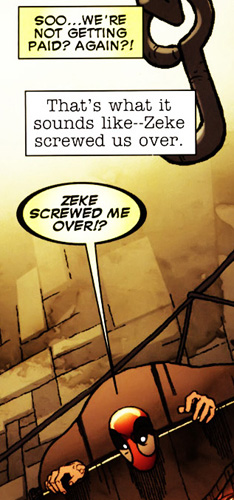
Deadpool is also famous for breaking the fourth wall, which is the imaginary line between the book and the audience, through which the audience can see but the characters normally cannot. He will often turn toward the reader and speak directly to them, much to the confusion of the rest of the characters on the page.
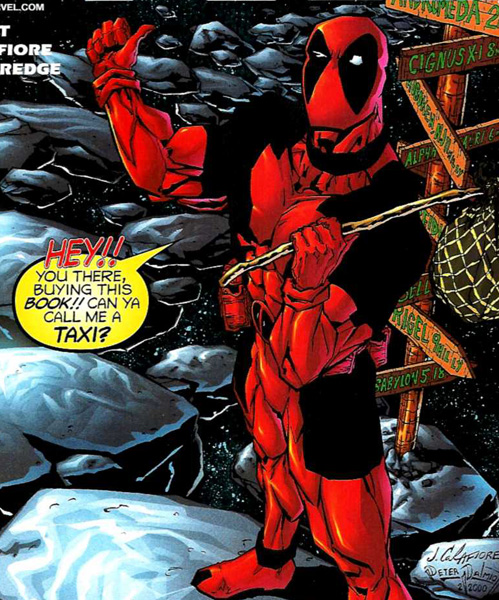
He also breaks the fourth wall to poke fun at his own past. Deadpool was created in part by Rob Liefeld, famous among comic fans for the period of time he spent drawing ridiculous pouches, enormous guns, and women without feet.
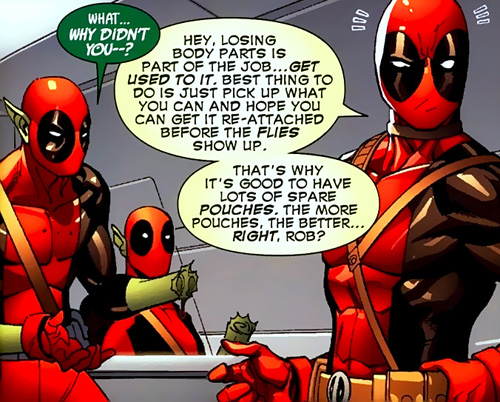
Amusingly enough, it’s one of the traits that tends to add to the other characters’ perception of him as crazy… but it’s one of the things that can make the reader less sure of the same fact.
There are two things in the current ongoing Deadpool title that are big breaks in the fourth wall in every issue. The first is the recap page that starts every issue off. It’s a common feature in Marvel comics, and while most of them just take a page at the beginning and give a two or three paragraph description of the events to that point, a few have come up with innovative formats in which to do it. Young Avengers gives its recap with a page called “Yamblr,” which is a clear reference to popular blogging site Tumblr. Deadpool, on the other hand, narrates his own recap page.
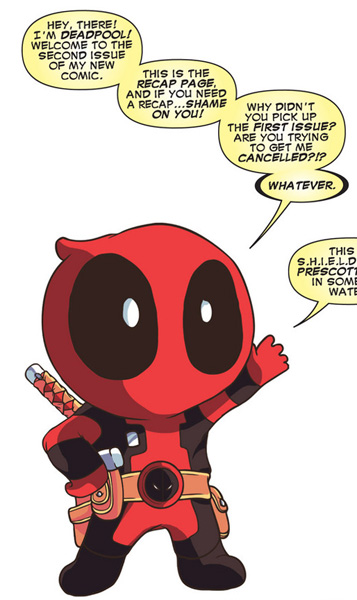
Also, instead of having the normal letters to the editor/writer/creative team page, Deadpool has a “Write to Deadpool” page. All of the questions are directed to the character himself, and he answers each and every one.

Occasionally, this leads to some hilarious things, not only in the letters page, but in the comic itself. For instance, this…
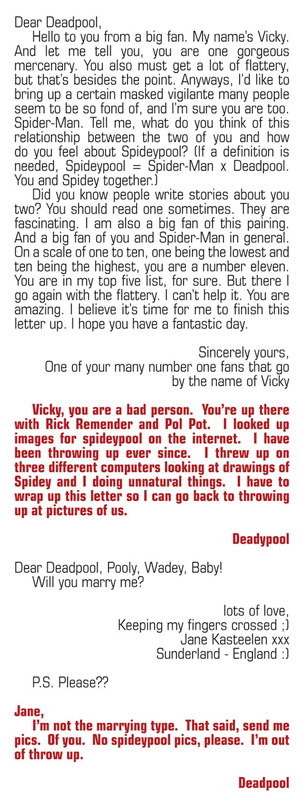
…leads to this.
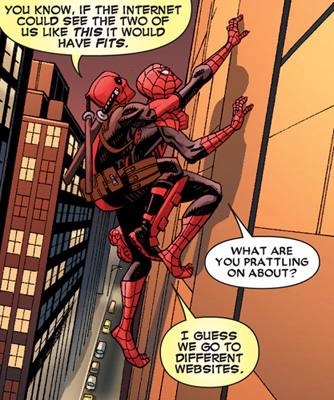
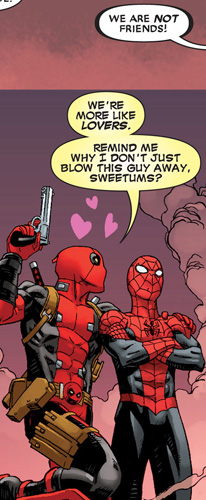
These elements make Deadpool one of the most entertaining reads available right now, but they make it an excellent example of postmodern literature as well. Postmodern literature is any work that breaks what we consider the norms of storytelling. The best example I can think of is David Wiesner’s The Three Pigs, in which he retells the story of the three little pigs who build their houses out of straw, sticks, and stone… but instead of telling the story as we know it, the pigs manage to climb out of the story itself, break down the pages, and escape the wolf entirely.

Deadpool employs a lot of the same kinds of instruments. We get that breaking of the fourth wall, an unconventional type of storytelling, an extremely unreliable narrator, a lot of metafiction (constant reminders that this is fiction, and at least some of the characters are aware of it), and a large amount of irony and dark humor. It also relies on intertextuality, which is the idea that no work exists in a vacuum – think of characters in a book watching a TV show from the real world, or having read classic literature. Deadpool references other works a lot, and is even aware that he, himself, is part of a comic.
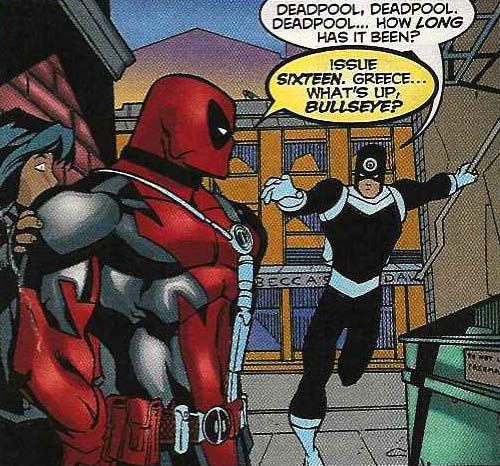
The book also plays around with time and magic, both of which are elements of postmodern literature, and has elements of maximalism (an extreme overuse of detail). It’s definitely a book from the postmodern tradition, and it earns its place there with every issue, doing the unexpected and keeping us on our toes.
Books like Deadpool – books that take us outside of the Modernist way of storytelling and force us to think outside the box – are important. They make the readers invest a little more in the story, and get people to think and talk and discuss. It’s different, which makes it stand out, and makes it memorable. What’s even better, Deadpool has been this way since very nearly his beginning – and he shows no signs of changing in the future.
We’ve got a lot of Deadpool to look forward to.
Deadpool Volume 4, Book 1: Dead Presidents. Written by Brian Posehn and Gerry Duggan; art by Tony Moore. Published 2013; collects #1-6. Find it on Amazon or buy it from comixology.
The Three Pigs. Written and illustrated by David Wiesner. Published 2001. Find it on Amazon.
Comments? Questions? Leave a reply! I’ll be happy to talk comics with you.

What did you think of Deadpool on Rememder’s Uncanny X-Force run? I thought he was perfectly written there. Funny, but not obnoxious. Cleary insane, but he still cared about Kid Apocalypse. And not too much Fourth Wall breaking – which is hard to do in a non-obnoxious way.
I actually haven’t read that run – the X-books hold almost no interest for me, for whatever reason. I’m not surprised that Remender wrote him well, though – he’s a fantastic writer, especially with really quirky characters.
I would strongly recommend it as a book that’s not really an X-Men book at all. It really could have been written about nearly any group of super heroes. The fact that it’s the X-Men just gives it an already built-in set of personalities and the main villain. But, really, it’s about relationships in the same way as Mark Waid’s Irredeemable
[…] breaks in that reality are there?! Deadpool is a fascinating character, and there have been many analyses done about his place in comic lore and […]